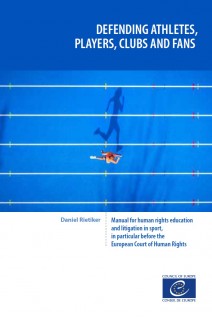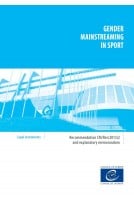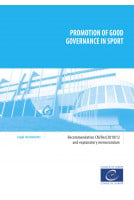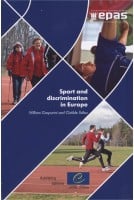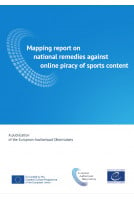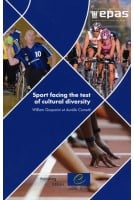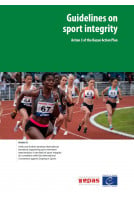PrefaceIntroductory noteForewordList of abbreviationsGeneral introductionI. Theoretical setting1. Definitions
1.1. Key concepts and particularities of the field of sport
1.1.1. Autonomy of the sport movement and lex sportiva
1.1.2. Mainly private actors
1.2. Key concepts and particularities of human rights law and the Convention
1.2.1. Binding nature of the Convention and the right to individual application
1.2.2. Effectiveness and execution of judgments
1.2.3. Dynamic interpretation and margin of appreciation
1.2.4. Harmonious interpretation
2. Who can be held liable for human rights in sport?
2.1. The states
2.1.1. The trilogy of legal duties imposed on states by human rights treaties
2.1.2. Negative and positive obligations of states parties to human rights treaties
2.1.3. The “duty to protect” under the UN Guiding Principles and Council of Europe CM/Rec(2016)3
2.2. Private actors, particularly sports governing bodies
2.2.1. The duty of due diligence
2.2.2. Voluntary commitments by sport governing bodies
3. Human rights violations occurring abroad
3.1. Extraterritorial effect of human rights treaties
3.2. The special responsibility of Switzerland and other host states of sports governing bodies
3.3. Shared responsibility for human rights violations
3.4. Conclusions of Part I
II. Issues already addressed by the Court4. Access to a court, fair trial and other procedural guarantees (Articles 6, 7 and 8 of the Convention)
4.1. In general
4.2. In sports arbitration
4.2.1. Mutu and Pechstein v. Switzerland (public hearing, independence and impartiality of CAS)
4.2.2. Bakker v. Switzerland (right of access to a court and fair trial before the Federal Tribunal)
4.2.3. Ali Riza and Others v. Turkey (independence and impartiality of arbitration bodies of the Turkish Football Federation)
4.2.4. Ali Riza v. Switzerland (right of access to a court before CAS and the Swiss Federal Tribunal)
4.2.5. Platini v. Switzerland (CAS proceedings and proportionality of FIFA sanctions challenged under Article 8 of the Convention)
4.3. Final remarks
5. Privacy in the fight against doping (Article 8 of the Convention and Article 2 of Protocol No. 4)
5.1. Introductory remarks on the fight against doping and Article 8
5.2. Fédération Nationale des Associations et Syndicats Sportifs (FNASS) and Others v. France
5.3. Final remarks
6. Freedom of expression of players and athletes (Article 10 of the Convention)
6.1. Introductory remarks on freedom of expression
6.2. Three Turkish football cases delivered on 18 May 2021
6.2.1. Sedat Doğan
6.2.2. Naki and AMED Sportif Faaliyetler Kulübü Derneği
6.2.3. İbrahim Tokmak
6.3. The limits of freedom of expression: the Šimunić case
6.4. Final remarks
7. Human rights of fans, in particular in the fight against hooliganism
7.1. Introductory remarks
7.2. Right to liberty and security of fans (Article 5 of the Convention)
7.2.1. Introductory remarks on Article 5
7.2.2. Ostendorf v. Germany
7.2.3. S., V. and A. v. Denmark
7.2.4. Final remarks
7.3. Right of fans not to be ill-treated by security personnel (Article 3 of the Convention)
7.3.1. Introductory remarks on Article 3
7.3.2. Hentschel and Stark v. Germany
7.3.3. Final remarks
7.4. Right to life of fans (Article 2 of the Convention)
7.4.1. Introductory remarks on Article 2
7.4.2. Harrison and Others v. the United Kingdom
7.4.3. Final remarks in the light of the Saint-Denis Convention
7.5. Right of fans not to be tried or punished twice (Article 4 of Protocol No. 7)
7.5.1. Introductory remarks on Article 4 of Protocol No. 7
7.5.2. Velkov v. Bulgaria
7.5.3. Final remarks
7.6. Right of fans to freedom of expression (Article 10 of the Convention)
7.6.1. Introductory remarks
7.6.2. Maguire v. the United Kingdom
7.7. Freedom of association of fan clubs (Article 11 of the Convention)
7.7.1. Introductory remarks on freedom of association (Article 11)
7.7.2. Association Nouvelle Des Boulogne Boys v. France
7.7.3. Les Authentiks and Supras Auteuil 91 v. France
7.7.4. Final remarks
7.8. Conclusions of Part II
III. Potential issues at stake before the Court, particularly for vulnerable groups Introduction to Part III
8. Discrimination
8.1. Article 14 of the Convention and Protocol No. 12
8.2. Discrimination against persons with disabilities
8.2.1. Athletes and players
8.2.2. Fans and spectators
8.3. Discrimination against women, in light of the Istanbul Convention
8.3.1. The FIFPro report
8.3.2. Developments in the USA
8.3.3. Examples of discrimination based on gender
8.4. Particular discrimination issues of gender identity
8.4.1. Introductory remarks
8.4.2. Intersex athletes and players
8.4.3. Transgender athletes and players
9. Violence and sexual abuse
9.1. Introductory remarks
9.2. Against women, in light of the Istanbul Convention
9.3. Against children, in light of the Lanzarote Convention
9.4. Particular issue: the right to be informed about and protected against risks to life and health, especially brain damage, of certain contact sports
10. Protection of athletes and players against hate speech
10.1. Hate speech against members of racial or ethnic minorities
10.2. Hate speech based on sexual orientation or gender identity
11. Trafficking in human beings
11.1. Transfer of players, in particular minors
11.2. Workers in stadium construction and supply chains
11.3. Final remarks
12. Conclusions of Part III
IV. Litigating human rights in sport in practice: points to remember when applying to the Court Introduction to Part IV
12. Procedure
12.1. Lodging an application (Rule 47)
12.2. The procedure before the Court
12.2.1. Judicial formations
12.2.2. Representation of applicants
12.2.3. No court fees
12.2.4. Publicity of the proceedings and request for anonymity and confidentiality
12.2.5. Priority treatment
12.3. Admissibility criteria (Article 35 of the Convention)
12.3.1. Applicable rules
12.3.2. Four-month rule (former six-month rule)
12.3.3. Exhaustion of local remedies
12.4. Just satisfaction (Article 41 of the Convention)
12.5. Third party intervention (Article 36 of the Convention)
12.6. Execution of final judgments (Article 46 of the Convention)
General conclusionsBibliographyAppendices
Appendix I: Rule 47
Appendix II: Application form
Appendix III: Case law cited
1. European Court of Human Rights
2. Other jurisdictions
